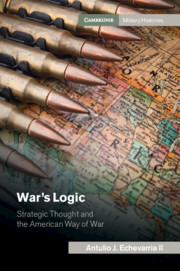Book contents
- War’s Logic
- Cambridge Military Histories
- War’s Logic
- Copyright page
- Dedication
- Contents
- Acknowledgments
- Introduction
- Part I First Principles and Modern War
- Part II The Revolt of the Strategy Intellectuals
- Part III The Counterrevolution of the Military Intellectuals
- Part IV The Insurrection of the Operational Artists
- Conclusion
- Notes
- Select Bibliography
- Index
Conclusion
Published online by Cambridge University Press: 05 February 2021
- War’s Logic
- Cambridge Military Histories
- War’s Logic
- Copyright page
- Dedication
- Contents
- Acknowledgments
- Introduction
- Part I First Principles and Modern War
- Part II The Revolt of the Strategy Intellectuals
- Part III The Counterrevolution of the Military Intellectuals
- Part IV The Insurrection of the Operational Artists
- Conclusion
- Notes
- Select Bibliography
- Index
Summary
Over the course of the twentieth century, America’s strategic theorists drew from at least four paradigms of war’s nature: traditional, modern, materialist, and political. The traditional paradigm remained in vogue until the 1950s, even though the expansion of airpower during the 1920s and 1930s qualitatively changed the character of war. For that reason, the same three Jominian core principles – concentration, offensive action, and decision by battle – remained operative. The development of nuclear weapons in the late 1940s and 1950s, however, raised concerns over those principles and the traditional paradigm. As a result, it was strongly challenged by the political model, through the vehicle of limited war theory. By the late 1950s, the political model was in open conflict with the traditional paradigm. By this point, the principles of limited war theory had taken precedence over the core Jominian imperatives. In this case, a change in the character of war, or rather a near-change since nuclear weapons were not used after 1945, had created competing paradigms in the American way of thinking about war.
- Type
- Chapter
- Information
- War's LogicStrategic Thought and the American Way of War, pp. 207 - 227Publisher: Cambridge University PressPrint publication year: 2021

